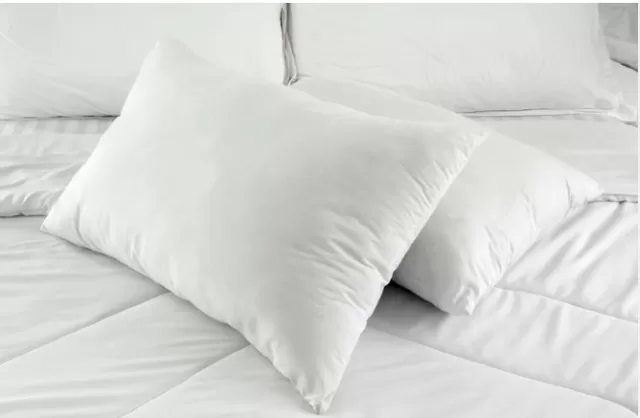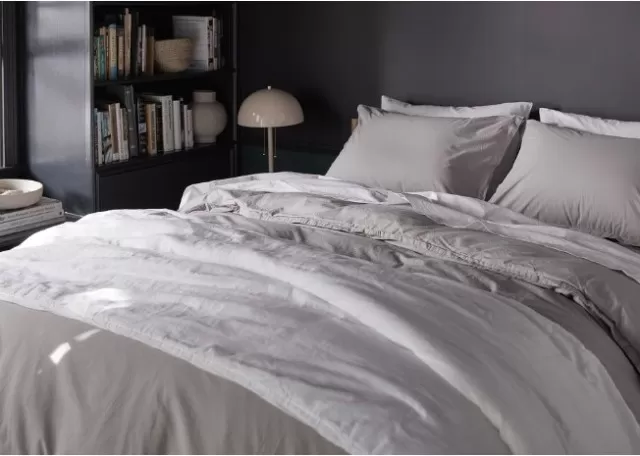Replacing Bedding: Guidelines for Optimal Comfort. Whether we’re resting or lounging, our time in bed is precious. To maintain an inviting sleep space, it’s essential to periodically evaluate and refresh our bedding.
While regular laundering is important, certain factors indicate the need for replacement due to wear, stains, and decreased comfort.
Pillow Replacement: Maintaining Comfort and Hygiene

When it comes to pillows, regular replacement is key to ensure optimal comfort and hygiene.
According to Melissa Poepping, founder of The Chemical Free Home, pillows should be replaced once per year. Over time, pillows tend to lose their shape and fluff, which can affect their support and comfort.
Additionally, the accumulation of oils from our face and hair adds to the need for replacement.
If you want to extend the lifespan of your pillows a bit longer, you can give them a thorough wash.
Follow these steps to restore their shape:.
Check the care label: Before washing your pillows, check the care label to ensure they are machine washable.
Some pillows may require specific cleaning methods.
Machine wash: Place two pillows in the washing machine to maintain balance.
Use a mild detergent and run a gentle cycle with warm water. This helps remove dirt, oils, and allergens.
Rinse and spin: After the wash cycle is complete, run an extra rinse cycle to ensure all detergent is removed.
Then, spin dry the pillows to remove excess water.
Dry thoroughly: Place the pillows in the dryer with a couple of tennis balls or dryer balls to fluff them up.
Set the dryer to a low heat or air-dry setting. Ensure the pillows are completely dry to prevent mold or mildew growth.
By following these tips, you can maintain the freshness and comfort of your pillows for a longer period.
However, keep in mind that proper care and regular replacement will help ensure you have the best sleep experience possible.
Pillowcase Replacement: Freshness and Cleanliness for Better Sleep
When it comes to maintaining a fresh and clean sleep environment, pillowcase replacement is an important consideration.
According to Katie Dills, Senior Vice President of The Cleaning Authority, pillowcases should be replaced every one to two years, or sooner if they have become worn, faded, or stained. Regularly washing your pillowcases and refreshing them with new ones helps ensure optimal hygiene and comfort.
The frequency of pillowcase replacement is based on the accumulation of sweat, stains, dust, and dead skin cells that naturally occur during sleep.
To keep your pillowcases fresh and clean, follow these guidelines:.
Regular washing: It is recommended to wash your pillowcases weekly or as often as needed.
Use a mild detergent and follow the care instructions on the label.
Visual inspection: Regularly inspect your pillowcases for signs of wear, fading, or stains.
If you notice any significant damage or discoloration that cannot be removed through washing, it may be time to replace them.
Hygiene considerations: Keep in mind that pillowcases come into direct contact with your face, and accumulated dirt and oils can impact your skin health.
Regular replacement helps maintain a clean sleep surface.
By adhering to these practices, you can ensure a fresh and comfortable sleep environment.
Regularly washing and replacing your pillowcases contributes to a healthier and more enjoyable sleep experience.
Bed Sheet Replacement: Longevity and Comfort for Restful Sleep

When it comes to the lifespan of bed sheets, proper care and quality play a significant role.
With regular maintenance and washing, bed sheets can last up to five years or even longer, depending on the material and quality. Katie Dills, Senior Vice President of The Cleaning Authority, highlights that 100% cotton, 100% Egyptian cotton, and linen are among the most durable and long-lasting sheet options available.
Here are some key points to consider for maximizing the lifespan of your bed sheets:.
Material selection: Opt for high-quality sheets made from 100% cotton, 100% Egyptian cotton, or linen.
These materials are known for their durability and longevity due to their strong fibers.
Proper care: Follow the care instructions provided by the manufacturer.
Regularly wash your sheets using a gentle cycle and mild detergent. Avoid using harsh chemicals or bleach, as they can weaken the fabric over time.
Maintenance routine: Rotate and alternate your sheet sets to distribute wear evenly.
This can help extend the lifespan of individual sets and reduce the frequency of replacement.
Visual inspection: Regularly check your sheets for signs of wear, thinning fabric, or significant pilling.
If you notice any significant damage or deterioration, it may be time to consider replacing them.
By choosing high-quality materials, following proper care guidelines, and conducting regular maintenance, you can enjoy the comfort and longevity of your bed sheets for up to five years or more.
Investing in durable sheet options and maintaining them well will contribute to a restful and enjoyable sleep experience.
Quilt Replacement: Preserving Beauty and Comfort for Years to Come

Quilts are not only functional but also serve as beautiful decorative pieces that add charm to our bedrooms.
With their intricate designs and hand-stitched craftsmanship, quilts require special care to maintain their longevity. While they may not withstand frequent washing, routine maintenance can help extend their lifespan.
Here are some key points to consider for maximizing the lifespan of your quilts:.
Spot cleaning: To preserve the delicate stitching and fabric, spot clean your quilt whenever possible.
Use a gentle cleaner or fabric freshener to target specific areas without subjecting the entire quilt to washing.
Seasonal rotation: Consider having different quilts for each season.
This not only allows you to change the look and feel of your bedding but also reduces wear and tear on individual quilts. Properly store quilts not in use to protect them from dust and sunlight.
Freshening up: Take advantage of mild weather by hanging your quilt outside on a line during spring, summer, or fall.
This helps to freshen it up and remove any lingering odors.
Regular inspection: Periodically check your quilt for signs of damage, such as fraying, fading, or irreversible stains.
If the quilt has experienced significant wear and tear or is beyond repair, it may be time to consider replacing it.
By adopting these practices, you can extend the lifespan of your quilts to approximately three to five years.
However, always prioritize the preservation of the quilt’s beauty and craftsmanship, and be ready to invest in a new one when necessary. With proper care, your quilts will continue to provide warmth, comfort, and a touch of elegance to your bedroom for years to come.
Longevity and Comfort: When to Replace Your Comforter
A cozy and well-maintained comforter can be a cherished companion for many years, providing warmth and comfort during chilly nights.
While the lifespan of a comforter varies depending on its material and usage, proper care and regular maintenance can extend its longevity.
Consider the following guidelines when determining if it’s time to replace your comforter:.
Material matters: The type of material used in your comforter plays a significant role in its durability.
High-quality down or synthetic fillings, such as microfiber or polyester, are known for their resilience and can last longer than other materials.
Cleaning and maintenance: Regularly washing and fluffing your comforter is essential for its upkeep.
Follow the manufacturer’s care instructions and pay attention to any specific guidelines for cleaning and drying. Proper maintenance can help prolong the lifespan of your comforter.
Visible wear and tear: Over time, your comforter may show signs of wear and tear, such as fading, thinning, or loss of fill.
If your comforter starts to look dull, flat, or shows visible damage that cannot be repaired, it may be time to consider a replacement.
Allergies and hygiene: If you develop allergies or respiratory issues that are exacerbated by your comforter, it might be an indication that it needs to be replaced.
Additionally, if your comforter has been exposed to significant spills, stains, or pet dander that cannot be effectively cleaned, it may be time for a fresh start.
As a general guideline, a well-cared-for comforter can last anywhere from 15 to 20 years.
However, individual factors such as usage, quality, and personal preferences can influence its lifespan. Pay attention to the condition of your comforter and make a decision based on its appearance, functionality, and your comfort.
Revitalize Your Bedding: When to Replace Your Duvet Cover

A duvet cover adds style and protection to your duvet insert, creating a cozy and inviting bed.
While duvet inserts are usually replaced less frequently, the lifespan of a duvet cover can vary depending on usage, maintenance, and material quality. Regular care and occasional replacement ensure a fresh and comfortable sleep environment.
Consider the following factors when deciding if it’s time to replace your duvet cover:.
Wear and tear: Over time, a duvet cover can experience wear and tear due to regular use, washing, and handling.
Inspect your duvet cover for signs of fraying, fading, or weakening fabric. Loose buttons, broken zippers, or other functional issues may also indicate the need for a replacement.
Hygiene and cleanliness: Duvet covers accumulate dust, body oils, and other allergens over time.
Regular cleaning is essential to maintain a fresh and hygienic sleep environment. Washing your duvet cover every other week, following the care instructions provided, helps prolong its lifespan.
However, even with proper care, the accumulation of stains or odors may eventually warrant a replacement.
Style and decor: As your tastes and home decor evolve, you may desire a change in your bedroom’s aesthetic.
Updating your duvet cover allows you to introduce new colors, patterns, or textures, revitalizing the overall ambiance of your sleeping space.
As a general guideline, consider replacing your duvet cover every three to five years.
However, individual factors such as material quality, usage frequency, and personal preferences can influence this timeframe. Regularly assess the condition of your duvet cover and make a decision based on its appearance, functionality, and your satisfaction.
*The information is for reference only.